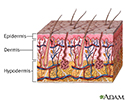Donovanosis (granuloma inguinale)
Granuloma inguinale; Sexually transmitted disease – donovanosis; STD - donovanosis; Sexually transmitted infection – donovanosis; STI - donovanosis
Donovanosis (granuloma inguinale) is a sexually transmitted disease that is rarely seen in the United States.
Causes
Donovanosis (granuloma inguinale) is caused by the bacteria Klebsiella granulomatis . The disease is commonly found in tropical and subtropical areas such as southeast India, Guyana, and New Guinea. There are about 100 cases reported per year in the United States. Most of these cases occur in people who have traveled to or are from places where the disease is common.
The disease spreads mostly through vaginal or anal intercourse. Very rarely, it spreads during oral sex.
Men are affected more than twice as often as women. Most infections occur in people ages 20 to 40.
Symptoms
Symptoms can occur 1 to 12 weeks after coming in contact with the bacteria that cause the disease.
- About one half of infected men and women have sores in the anal area.
- Small, beefy-red bumps appear on the genitals or around the anus.
-
The skin gradually wears away, and the bumps turn into raised, beefy-red, velvety
nodules
called granulation tissue. They are often painless, but they bleed easily if injured.
Nodules
Skin nodules are solid or cystic raised bumps in the skin that are wider than 1 centimeter (cm), but less than 2 cm.
 ImageRead Article Now Book Mark Article
ImageRead Article Now Book Mark Article - The disease slowly spreads and destroys genital tissue.
- Tissue damage may spread to the groin.
- The genitals and the skin around them lose skin color.
In its early stages, it may be hard to tell the difference between donovanosis and chancroid .
Chancroid
Chancroid is a bacterial infection that is spread through sexual contact.

In the later stages, donovanosis may look like advanced genital cancers, lymphogranuloma venereum , and anogenital cutaneous amebiasis .
Lymphogranuloma venereum
Lymphogranuloma venereum (LGV) is a sexually transmitted bacterial infection.

Amebiasis
Amebiasis is an infection of the intestines. It is caused by the parasite Entamoeba histolytica.

Exams and Tests
Tests that may be done include:
-
Culture of tissue sample
(hard to do and not routinely available)
Culture of tissue sample
A skin lesion biopsy is when a small amount of skin is removed so it can be examined. The skin is tested to look for skin conditions or diseases. A...
 ImageRead Article Now Book Mark Article
ImageRead Article Now Book Mark Article - Scrapings or biopsy of lesion
Laboratory tests, such as those used to detect syphilis, are available only on a research basis for diagnosing donovanosis.
Treatment
Antibiotics are used to treat donovanosis. These may include azithromycin, doxycycline, ciprofloxacin, erythromycin, and trimethoprim-sulfamethoxazole. To cure the condition, long-term treatment is needed. Most treatment courses run 3 weeks or until the sores have completely healed.
A follow-up examination is important because the disease can reappear after it seems to be cured.
Outlook (Prognosis)
Treating this disease early decreases the chances of tissue damage or scarring. Untreated disease leads to damage of the genital tissue.
Possible Complications
Health problems that may result from this disease include:
- Genital damage and scarring
- Loss of skin color in genital area
- Permanent genital swelling due to scarring
When to Contact a Medical Professional
Call for an appointment with your health care provider if:
- You have had sexual contact with a person who is known to have donovanosis
- You develop symptoms of donovanosis
- You develop an ulcer in the genital area
Prevention
Avoiding all sexual activity is the only absolute way to prevent a sexually transmitted disease such as donovanosis. However, safer sex behaviors may reduce your risk.
The proper use of condoms, either the male or female type, greatly decreases the risk of catching a sexually transmitted disease. You need to wear the condom from the beginning to the end of each sexual activity.
References
Ballard RC. Klebsiella granulomatis (donovanosis, granuloma inguinale). In: Bennett JE, Dolin R, Blaser MJ, eds. Mandell, Douglas, and Bennett's Principles and Practice of Infectious Diseases . 8th ed. Philadelphia, PA: Elsevier Saunders; 2015:chap 237.
Richens J. Granuloma inguinale. In: Magill AJ, Hill DR, Solomon T, Ryan ET, eds. Hunter's Tropical Medicine and Infectious Disease . 9th ed. Philadelphia, PA: Elsevier Saunders; 2013:chap 52.
-
Skin layers - illustration
The skin is the largest organ of the body. The skin and its derivatives (hair, nails, sweat and oil glands) make up the integumentary system. One of the main functions of the skin is protection. It protects the body from external factors such as bacteria, chemicals, and temperature. The skin contains secretions that can kill bacteria and the pigment melanin provides a chemical pigment defense against ultraviolet light that can damage skin cells. Another important function of the skin is body temperature regulation. When the skin is exposed to a cold temperature, the blood vessels in the dermis constrict. This allows the blood which is warm, to bypass the skin. The skin then becomes the temperature of the cold it is exposed to. Body heat is conserved since the blood vessels are not diverting heat to the skin anymore. Among its many functions the skin is an incredible organ always protecting the body from external agents.
Skin layers
illustration
-
Skin layers - illustration
The skin is the largest organ of the body. The skin and its derivatives (hair, nails, sweat and oil glands) make up the integumentary system. One of the main functions of the skin is protection. It protects the body from external factors such as bacteria, chemicals, and temperature. The skin contains secretions that can kill bacteria and the pigment melanin provides a chemical pigment defense against ultraviolet light that can damage skin cells. Another important function of the skin is body temperature regulation. When the skin is exposed to a cold temperature, the blood vessels in the dermis constrict. This allows the blood which is warm, to bypass the skin. The skin then becomes the temperature of the cold it is exposed to. Body heat is conserved since the blood vessels are not diverting heat to the skin anymore. Among its many functions the skin is an incredible organ always protecting the body from external agents.
Skin layers
illustration
Review Date: 9/10/2015
Reviewed By: Jatin M. Vyas, MD, PhD, Assistant Professor in Medicine, Harvard Medical School; Assistant in Medicine, Division of Infectious Disease, Department of Medicine, Massachusetts General Hospital, Boston, MA. Also reviewed by David Zieve, MD, MHA, Isla Ogilvie, PhD, and the A.D.A.M. Editorial team.

